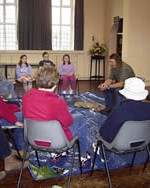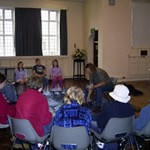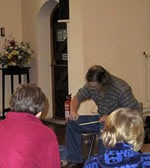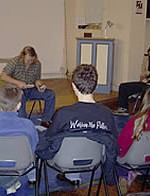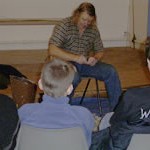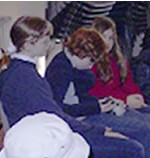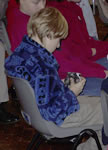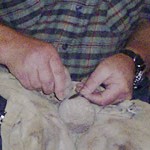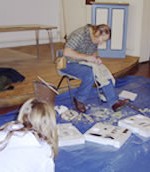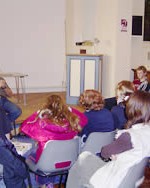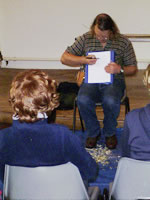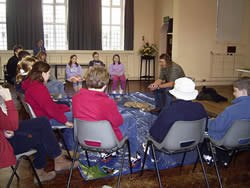 This month’s session of YAC was devoted to prehistoric flint working. Members were lucky to have a real expert on hand, Phil Harding, best known for his work with Wessex Archaeology and on Channel 4’s Time Team. His task, should he choose to accept it, was to re-create a Neolithic arrow. Before this however Phil kindly offered to hand out the prizes for the picture and anagram puzzles from the Christmas party. Winners got chocolates and a signed photo of Phil.
This month’s session of YAC was devoted to prehistoric flint working. Members were lucky to have a real expert on hand, Phil Harding, best known for his work with Wessex Archaeology and on Channel 4’s Time Team. His task, should he choose to accept it, was to re-create a Neolithic arrow. Before this however Phil kindly offered to hand out the prizes for the picture and anagram puzzles from the Christmas party. Winners got chocolates and a signed photo of Phil.
The Arrow
He began by first selecting a large flint nodule, which he explained came from the local chalk downs around Salisbury. This local source of flint he explained was probably one of the main reasons why we have so much prehistoric activity, in this part of Wiltshire. (Think Stonehenge and the Amesbury Archer)
Next he showed everyone all the different tools that a flint knapper would use. These included stone and antler ‘hammers’ and a selection of small tools made from carved antler and bone. Then the knapping began.
First he used a stone hammer to split a selection of flakes off the flint nodule. He then selected the most suitable of these to produce the arrowhead itself and used the others to strip the bark off a piece of hazel that would become the arrow’s shaft.
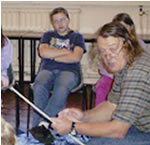 Whilst Phil was busy knapping away, members asked him questions about what he was doing and what prehistoric life might have been like: what did they hunt, how did they make bows, what other types of arrowheads have been found etc.
Whilst Phil was busy knapping away, members asked him questions about what he was doing and what prehistoric life might have been like: what did they hunt, how did they make bows, what other types of arrowheads have been found etc.
Members then, thanks to Caroline Beasley of Salisbury Museum, got to have a hands-on look at all sorts of other flint and prehistoric tools and objects.
Members got the chance to test their newly gained knowledge. Groups then were given bags of flints and had to work out if any of the bits of flint had been worked. If so, what might they have been used for? Finally members were given their new YAC folders for 2005, along with series of sheets all about flint working to go in them.

